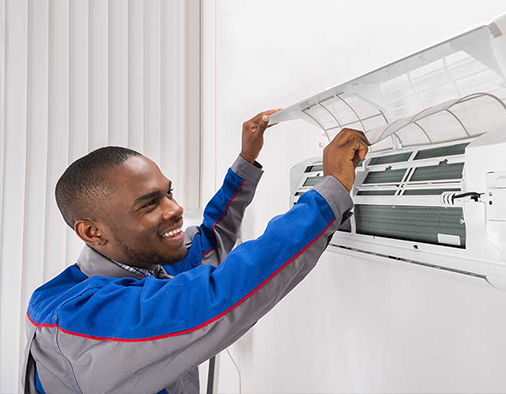Overview
The increasing development of heating, ventilation, and air-conditioning (HVAC) systems technology creates a number of employment opportunities in this long-standing trade poised for even more growth in the coming years. An HVAC technician installs, maintains, and repairs heating, air conditioning, and refrigeration systems. Professionals who work in this occupation might specialize in installation, or in maintenance and repair.
This program focuses on broad, transferable skills, including an understanding of the heating, air-conditioning, refrigeration and ventilation industry, and demonstrates elements of the industry such as planning, management, finance, technical and production skills, the underlying principles of technology, and health, safety, and environmental issues. The purpose of this program is to prepare students to perform entry-level HVAC maintenance and repair tasks in residential and commercial environments. This course is designed to prepare students to pursue the Environmental Protection Agency (EPA) 608 Core and 608 Small Appliances (Type 1) Certification. Students are eligible for an optional externship with a local employer after successful course completion.
Program Objectives
After completing this program, learners will be able to:
- Describe the building trades and technology industry and associated career paths
- Identify the professional skills required for success and career advancement in the industry
- Complete basic measuring tasks and math calculations required in the building trades workplace
- Explain the safety procedures and equipment commonly used in the building trades workplace
- Explain the proper use, care, maintenance, and safety considerations for using common hand tools
- Explain the proper use, care, maintenance, and safety considerations for using common power tools
- Identify common rigging equipment and procedures used on a construction site
- Read common construction drawings and plans
- Apply principles of heating, ventilation, air conditioning, and refrigeration to the installation, maintenance and repair of HVACR systems
- Apply safety practices to HVACR installation, maintenance, and repair practices
- Identify and safely use hand and power tools
- Understand and read construction drawings
- Describe trade licensing, certification, career paths, and responsibilities and characteristics available in the HVACR trade in residential, commercial and industrial areas
- Perform basic math and measuring tasks required in the HVAC trade
- Apply knowledge of electricity and electrical safety to HVACR installation, maintenance and repair
- Apply knowledge of heating, cooling, and air distribution systems and individual components to the HVACR installation, maintenance and repair
- Apply knowledge of different types of copper, plastic, and carbon steel piping in HVACR tasks
- Prepare, soldering, and brazing copper tubing safety
- Measure, cut, ream, thread, install, and join steep pipe in HVACR projects
- Understand Environmental Protection Agency (EPA) rules and regulations related to HVAC practices
- Understand EPA requirements for small appliances, refrigerants and hazardous chemicals
Certification
There is a National Certification exam available to students who successfully complete this program:
- Environmental Protection Agency (EPA) Section 608 Technician Certification
Note: Inclusion of National Certification exam vouchers vary from school and payment / finance method. To check if they are included, you may message any of our advisors through any of our available channels here
Financial Aid
Available Financial Aid / Grant Options
Military Affiliated
- Army Credentialing Assistance
To see if you qualify, message us here
